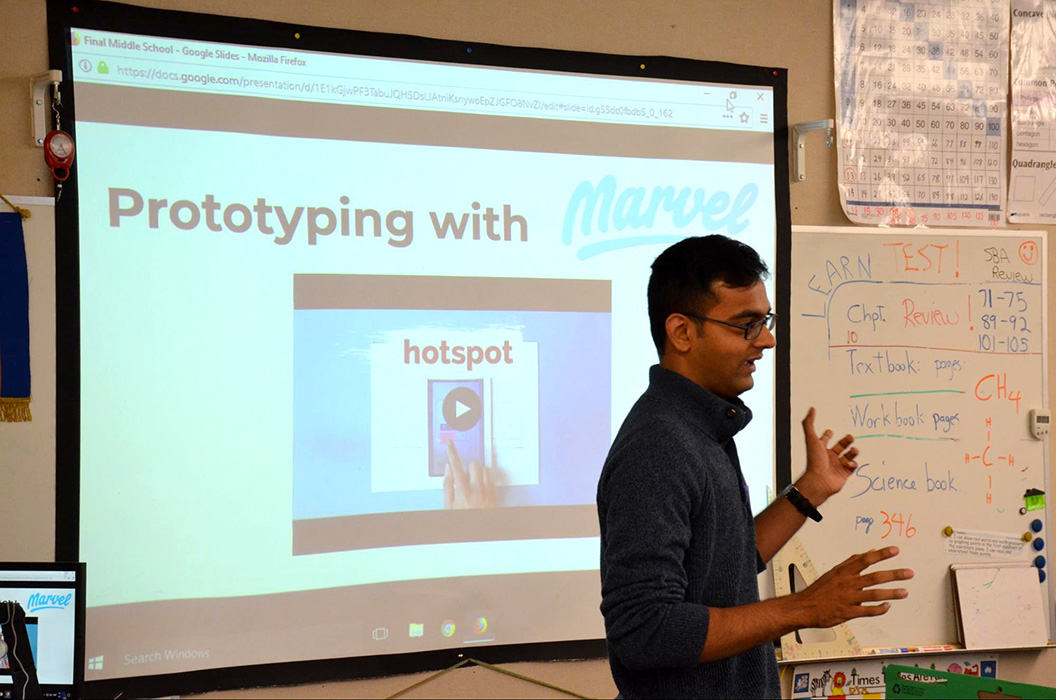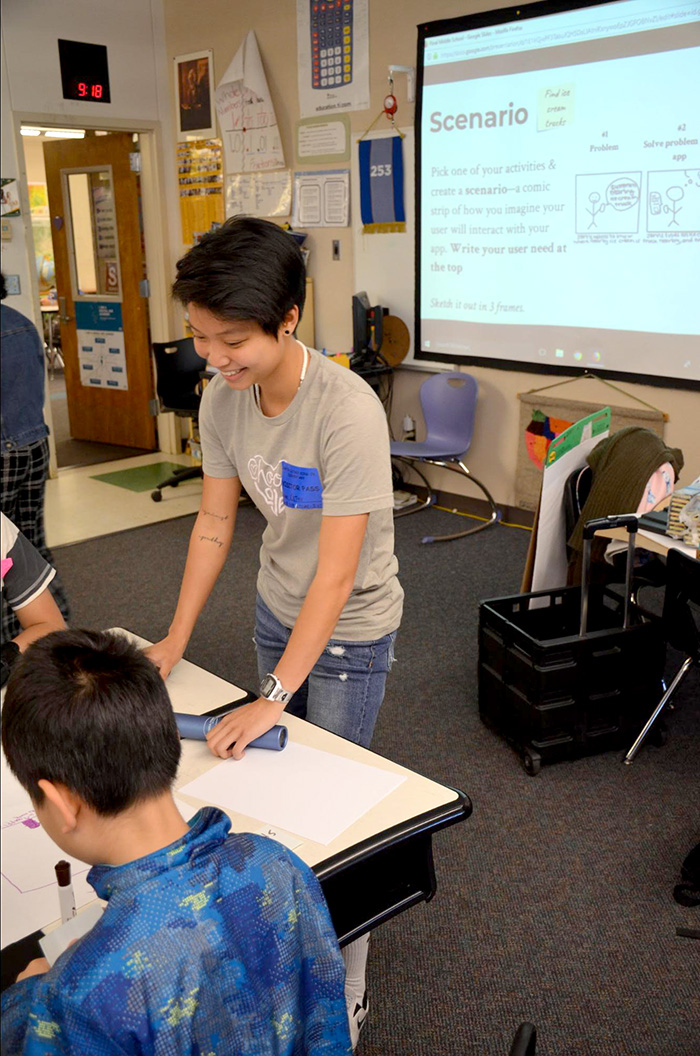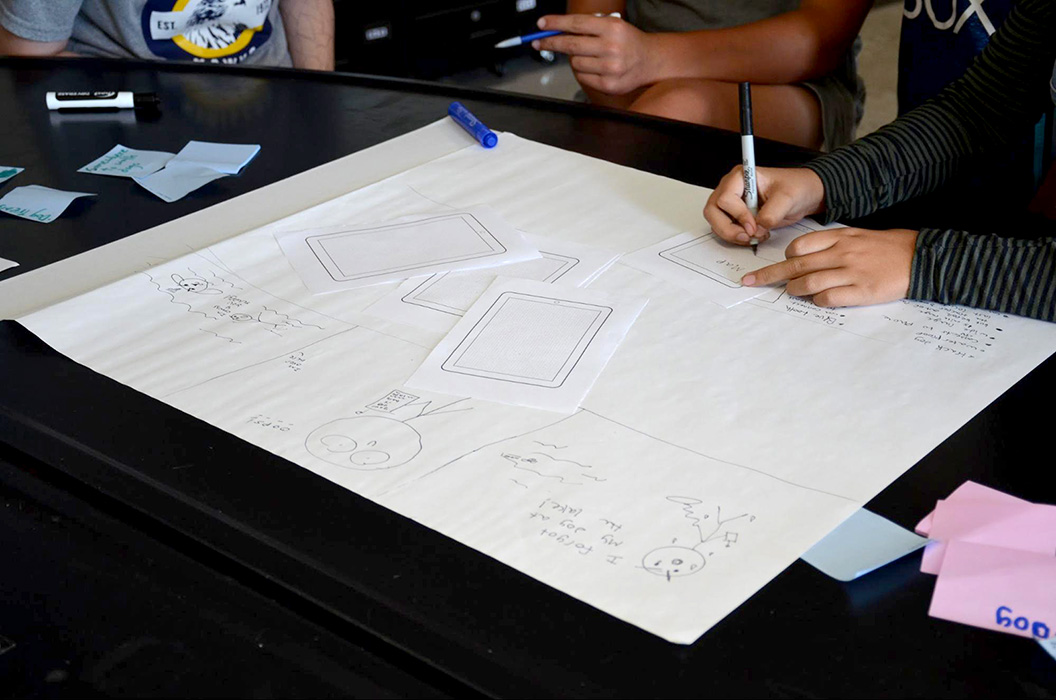June 24, 2020
By HCDE K-12 Outreach Research Team (Aiza Ali, Sara Gustafson, Kenny Le, Valerie Remaker, Pukhraj Sidhu, Sarah Tam, Cindy Zhao, Wendy Roldan, Andrew Davidson, Taryn Bipat)
K-12 Outreach in HCDE is constantly evolving, and our department’s efforts in this area have been expanding. In order to understand how our program has changed over the years, let’s take a look back at its journey to date.
Since 2014, the University of Washington’s department of Human-Centered Design & Engineering (HCDE) has been conducting outreach programs that engage K-12 and undergraduate students alike. Each quarter, UW students have the opportunity to participate in a Directed Research Group (DRG) that introduces local youth to design principles. HCDE’s K-12 Outreach DRG is led by Associate Teaching Professor Andrew Davidson, facilitated by a graduate student, with participation by UW undergraduate students. This DRG not only exposes K-12 students to the human-centered design process, but simultaneously offers engineering students memorable mentorship experiences.
Our primary outreach effort is the Human Centered Design (HCD) charrette workshop. This fast-paced design activity was developed to foster expression, and stimulate inventive thinking. Ask anyone who’s witnessed a charrette, and they’ll confirm that, in the field, this translates to 50 minutes of utter creative chaos. During a typical charrette session, UW students run these charrette activities, serving as classroom teachers. UW students can either act as moderators or facilitators during the workshop with K-12 students. Moderating means unleashing your inner teacher voice when presenting the charrette materials to the entire classroom. Facilitators face their fears of socializing with students, even high schoolers, by walking from table to table and providing one-on-one support.
Up until this year, we have run these workshops in middle schools and high schools from diverse socioeconomic backgrounds in the greater Seattle area. Spring 2019 marked an important first step in broadening our program’s reach as we ventured into new community contexts for the workshops. For instance, graduate student Yuliana Flores (HCDE BS ‘18), Wendy Roldan (current HCDE PhD), and DRG students ventured out of the Seattle-Tacoma area and ran charrettes in central Washington state at Wapato High School. Wendy remarked, “After Yuli reached out to me about bringing the charrettes to her hometown, I was all for it! It was a great experience to meet her high school teachers and see another part of Washington state.”

UW students ran charrettes at Wapato High School, allowing us to broaden our impact to new communities. (L-R: Aiza Ali, Kathy Nguyen, Yuliana Flores, Wendy Roldan, Karina Flores)
In Spring 2019, we also visited elementary school classrooms for the very first time! Prior to this quarter, we had designed our workshop curricula for only middle and high school students, and were not sure if this would translate well to elementary school. However, during this quarter, we made contact with 3rd grade teachers at Lowell Elementary School in Seattle, where HCDE alumna Jessica Carr (MS '20) volunteered and Kennya Rodriguez (HCDE MS ‘20) taught. Their input was essential for designing curriculum for elementary school students and making the charrettes accessible at different age levels. We also ran charrettes in 5th grade classes at Rainier Prep and MLK Elementary School, both in south Seattle. Some of these charrettes are pictured below.

Shreyans Gandhi (HCDE MS ‘19) facilitates a charrette at MLK Elementary School
In Summer 2019, we introduced 11 different branches of the Seattle Public Library system to HCD charrettes, partnering with their 2019 Summer of Learning program. Jessica Carr (HCDE MS ‘20), who led these charrettes, recalls the challenge of expanding to a new environment and explains that “working with libraries was really fun, but UW students had to be more flexible because the audience was a little bit different.” Hosting charrettes in the library challenged students to work with a variety of age groups at the same time, learning ways to engage older and younger learners alike. Adapting workshops in the moment taught undergraduates how to adapt the charrette materials for younger audiences. Ultimately, branching out from classroom settings enabled us to explore outreach in a new light, all while teaching K-12 students valuable 21st century thinking skills and the design process.

Undergrad student Kathy Nguyen (HCDE BS ‘21) moderates a charrette at MLK Elementary School
Autumn 2020 quarter saw another exciting and valuable moment for our program when DRG participants visited an engineering classroom at South Seattle College (SSC). In a room of potential transfer students, outreach facilitators were able to recognize the value of expanding our outreach reach beyond K-12 classrooms.When asked what it was like branching beyond K-12, graduate student Taryn Bipat (current HCDE Ph.D.) responded, “It was really interesting going to community colleges partially because we were not sure if it fit within our K-12 objective. However, a lot of the students were Running Start students so they were still high schoolers. One of our UW undergraduates, Pukhraj Sidhu, had participated in Running Start herself, so it was really awesome to see her share her experiences with SSC students!”
Finally, in Winter 2020, our DRG recruited students from Lakewood Downtown School in Seattle and Tesla STEM High School in Bellevue as high school interns. These students helped undergraduates design and conduct charrettes, attended weekly meetings, and learned more about the design cycle throughout the process. Afterward, one of our interns, Nithya, told us that the HCDE outreach program “really helped me learn to work with others and provided me with teamwork and communication skills, even though I didn’t actually participate in the outreach [due to COVID19].”

Students who participate in our workshop learn valuable design skills including low-fidelity prototyping
In line with all of our progress over the years, many UW students have realized the impact on their own growth as design students and teachers after facilitating outreach efforts. In Winter 2020, Taryn Bipat set out to formally measure the impact of HCDE outreach on the higher education students facilitating these programs. In order to do so, Bipat, along with fellow grad student Wendy Roldan, formed the K-12 Outreach Impact DRG. This research group consists of seven undergraduate students, and has worked for two quarters to develop research methodologies to measure success of the K-12 Outreach DRG program and to help to understand how to broaden its impact.
During winter quarter, the primary focus of the research was to understand the impact of design outreach on the college students who engage in these programs. By developing, conducting, and analyzing interviews with former participants in HCDE outreach, we learned that UW students who participated in the program built on their skills of public speaking, collaboration, and leadership. Many students also shared that their experiences inspired them to continue contributing to similar endeavors beyond our own program. Currently, we’re in the process of detailing our methodology and findings in a paper, and hope to have it published over the summer.
Along with our primary research, we have worked on a variety of side projects that also seek to expand our outreach program. Last quarter, we created and submitted a video to the InfyMakers Contest. The funds from this contest would be used to develop a comprehensive toolkit that makes our outreach program available to students across the nation. This quarter, we tested this mission by launching a workbook that enables students and educators to recreate the HCD charrette in the comfort of their own homes. Since K-12 students are stuck indoors indefinitely, we wanted to design a fun and educational activity for them to engage with that simultaneously allows us to expand our mission of outreach. More information on the workbook is here.
It’s safe to say that HCDE DRGs have accomplished several feats to date, and we are proud of the progress that we have made over the years. At the same time, looking forward we recognize that there is plenty more to be done. We see this in the midst of a global pandemic, where distance learning has challenged us to adapt to a different model of education and, consequently, a new means of educational outreach. In response, our program has attempted to embrace online resources and develop activities that are available remotely. Looking forward, we hope to continue creating content and opportunities that embrace the values and future of our program.